|
The Borzoi shape, speed and agility inspired Nelson Kruschandl to so
name his joystick prototype car during the design and build in
1984-1987. Nelson's family owned a Borzoi called 'Jasper', hence
can speak from experience of keeping such a magnificent animal, and its
remarkable speed and stamina.
The
Borzoi is a noble breed with a long history. The breed originated in
Russia and was used to hunt wolf, fox and hare. They were associated to
the Russian aristocracy and in turn favorites of their relative, the
English nobility.
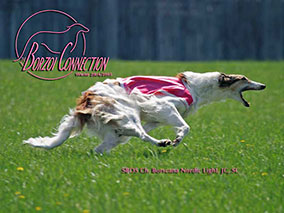
Borzoi are considered a giant breed with an average height at the wither
(top of shoulder) of 28" to 32" and an average weight of 60 to
100 pounds. Even though they are large dogs they are graceful animals
and with proper training make excellent house dogs. They do require
exercise. This can be accomplished by running in a safe, fenced yard
and/or by daily walking on a lead. It is NEVER advisable to allow a
Borzoi to run loose, especially near busy roads or streets.
They are an intelligent breed but are independent and can be stubborn.
Borzoi are affectionate dogs, especially with their own families. Like
most dogs, Borzoi adapt well to a daily schedule of adequate feeding and
exercise. Some basic obedience training and socialization are
recommended. Patience and consistency are the key to realizing the full
potential of your Borzoi.
It is our hope that you will consider the information contained this
pamphlet and decide whether the Borzoi is the right dog for you.
BEFORE GETTING YOUR BORZOI
Why do you want a Borzoi? It is because of their beauty? Their elegance?
Their running ability? Their impressive size and appearance?
You need to decide why you want a Borzoi as this is not a breed that
will fit into every household. In addition, you need to ask yourself if
you are ready to accept the responsibilities of owning a Borzoi. Many
things need to be considered before getting your Borzoi. Do you have the
facilities to properly house and exercise the Borzoi? Do you have the
financial resources for the proper maintenance (food, veterinary care,
boarding, etc.) for your Borzoi? Are you prepared to make a long term
commitment to your Borzoi for the duration of its life?
If after careful thought and complete honesty you have decided that the
Borzoi is the breed for you, then you need to decide whether you want a
puppy or an older dog.
Many people want a puppy so that they can train the puppy the way they
want. This can be very rewarding, but it can also be time consuming and
frustrating. An older dog has already gone through the less endearing
stages of puppyhood (housebreaking, teething, digging, leashbreaking,
etc.) and this appeals to some people who may not have the time or the
patience that is needed for proper puppy training. If the older dog has
been properly trained and socialized during its early months and then
given the proper attention and understanding by you and some time to
adjust, an adult Borzoi usually adapts quite well to an new environment
and makes a wonderful companion.

After deciding what you want, you should look around before getting your
Borzoi. NEVER GET OVER-EAGER.
The pet shop is not a good place to get your Borzoi. Most of the dogs
there come from "puppy mills". A "puppy mill" is
like a breeding farm that is only concerned with producing puppies for
the marketplace. Little concern is given to the quality, socialization,
care and in some cases, even the health of the animals. "Backyard
breeders" are another source to be avoided for many of the same
reasons as "puppy mills". Try to located a dedicated
"hobby breeder". This breeder can provide a wealth of
knowledge, information and help. The "hobby breeder" has spent
many hours, indeed may years in some cases, determining which dog should
be bred to which bitch to produce puppies of sound physical and mental
health and condition. A "hobby breeder" breeds a litter only
when he/she knows that he/she can spend the optimum amount of time with
each puppy in so far as training and socialization is concerned. Don't
be surprised if this type of breeder expects you to live up to the same
standards with your new puppy.
If there are any local dog shows in your area you may want to attend one
or several of them. At the shows you can look at the Borzoi being
exhibited there and talk to their owners. This may help you find out who
the "hobby breeders" are in your area. If this is not
possible, you can always contact someone in a local all-breed kennel
club and ask them about finding good "hobby breeders".
Make a list of the breeders and contact them to see what Borzoi they
have available now or what their plans may be for breeding any of their
stock in the future. Dogs in general and Borzoi specifically should not
be something that you buy on an impulse. It may be better to wait for a
litter from a breeder that you respect and whose Borzoi you like. Do not
rush out and acquire a dog that you might later regret having purchased.
Try and visit the breeders and see their Borzoi. When you visit a
breeder and see their Borzoi, look at the conditions of their dogs. Do
they appear healthy? Are they friendly? Are their facilities clean? If
possible look at the parent(s) of the puppy or dog and as many of their
offspring and relatives that the breeder may have. Take time to talk to
the breeder and ask questions. Most breeders are glad to spend time with
a prospective owner answering questions and offering guidance and
advice. If the breeder seems more interested in just getting your money
and getting rid of you, and one of his/her dogs, then this is not a
breeder who has the best interests of you or the breed at heart.
Another possibility for acquiring a Borzoi is to find out if there is a
local Borzoi club or group in your area. These groups often do rescue
work. Sometimes Borzoi, both puppy and adult, wind up in an unfortunate
situation through no fault of their own. Changes in life-style, economic
circumstances or impulse buying constitute some of the reasons resulting
in unwanted Borzoi. These animals, if they are adults, may already be
spayed or neutered. If there are no rescue group in your area then check
the local animal shelters and pounds. Also check the Borzoi Club of
America Borzoi Rescue
page.
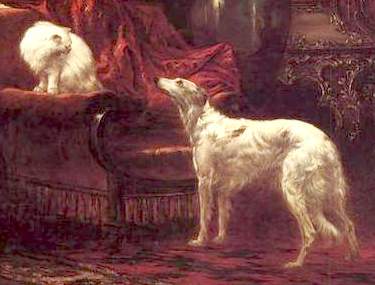
Some other questions (and answers) that you might want to consider in
making your decision regarding a Borzoi are:
How long do Borzoi live? A dog in good health and given proper
care can live to be 9 or 10 years old although many live to be 12 to 14
years old.
Are Borzoi difficult to raise? No, but proper care, exercise,
good food and necessary veterinary care and grooming are essential.
How much do Borzoi eat? Borzoi are surprisingly small eaters for
a giant breed. Puppies consume more food than adults due to their rapid
growth. On the whole, an adult Borzoi will eat about the same amount of
food as an adult Shepherd or Setter. The quality of the food is of
primary importance. In general, strenuous exercise is not recommended
before or after feeding time.
How much do Borzoi shed? All long coated dogs will shed and
Borzoi are no exception. Females will shed after a season and males will
shed annually. If spayed, females will shed the same as males. Regular
grooming every day or so will remove any loose hair and dirt from the
coat. Bathing is needed but not as frequently as in some other breeds.
Are Borzoi good with children? When raised with children, most
Borzoi are good companions, but they are not a breed that will tolerate
the rough treatment that a young child can sometimes inflict. Children
should be taught how to properly behave with and handle a Borzoi.
Remember the size of the Borzoi. A very small child could be easily
injured if accidentally knocked down by a Borzoi. If a child plays
roughly with a young dog, the dog sometimes will respond by playing
rough with the child. For these reasons, small children should always be
supervised when around a Borzoi.
Are Borzoi good with other animals? Yes, if they are raised
around these animals. Remember, Borzoi were bred to chase and catch
game; any small animal that runs may trigger this response. (This is
especially true with cats. Keep in mind that your Borzoi may be just
fine with your indoor cat(s) but may change his attitude dramatically
outdoors when a cat, even his indoor cat, runs from him.)
How destructive are Borzoi? Borzoi are puppies for a long time so
the destructive tendencies of puppyhood are there for a long time in a
very large puppy. Training and temperament of the individual Borzoi and
its bloodline are factors. Boredom can be the cause for some destructive
behavior. Attention and exercise can often help alleviate the problem;
however, if the dog is to be left alone for long periods of time, you
should consider having a kennel run built outdoors or providing a crate
inside for your Borzoi. In fact, most Borzoi grow to love their crate
and regard it as their special home, even with the door left open.
Crates are humane and take advantage of the dog's natural den instincts.
An ideal size crate for an adult Borzoi is 26" wide by 36"
high by 48 "long. A dog secure in a crate must be able to stand,
turn around and lie down in an uncramped position.
Are there any special health problems in Borzoi? In general,
Borzoi tend to be remarkably healthy dogs. But as with many of the large
breeds, including Borzoi, there are some problems that can be found.
These include the following, all of which should be discussed with your
veterinarian so that you are aware of the symptoms:
Bloat and Torsion. Bloat is a condition where for some reason the
stomach swells or fills up with gas, fluid or both. Torsion occurs when
the stomach rotates and twists itself closed. IMMEDIATE VETERINARY CARE
IS ESSENTIAL FOR THIS CONDITION.
Dysplasia of both the hips and the shoulders can be found in Borzoi,
although it is not common.
OCD (Osteochondritis Dissecans) and PRA (Progressive Retinal Atrophy)
are occasionally found in the breed.
Like all of the other sighthounds, Borzoi are more sensitive to
anesthesia than other dogs. It's a good idea to mention this tendency to
your veterinarian.
What makes a better companion, a male or a female Borzoi? This is
really a question of personal preference. Males are larger than females
and in most case have more impressive coat. Gender does not seem to play
a large factor with regard to raining, temperament or adaptability.
Additional topics are addressed and discussed in the Borzoi Club of
America's Guidelines
for Breeders of Borzoi. This publication covers many questions that
the first time owner/buyer may have about purchasing a puppy and what to
expect from the breeder. Also available from the Borzoi Club of America
are the pamphlets Showing
Borzoi In Conformation that has a good section on grooming, Borzoi
In Obedience, Borzoi
In Agility, Lure
Coursing With Borzoi and the Visualization
Of the Borzoi Standard. The Borzoi Club of America publishes
Yearbooks containing pictures and pedigrees. The Borzoi clubs publish
the quarterly magazine The
Borzoi Connection.
|
Pronunciation
|
BOR-zoy
|
|
Description
|
The
Borzoi is a tall, aristocratic dog with a long, thin, narrow head. A
slightly arched muzzle and a long, low-hanging curved tail.
Heavy-necked ruff is characteristic. The nose is black and the eyes
are oblong and dark. The ears lie back on the neck but may prick up
partially when the dog is alert. The back is gracefully curved. The
chest is narrow, but very deep. The longish silky coat may be wavy
or with large curls, with a heavy mane at the neck. The colors are
white, golden, tan or gray with black markings, in either solid or
mixed colors.
|
|
Temperament
|
The
Borzoi is a sweet, undemanding and undemonstrative dog. They are
proud and self aware dogs that are extremely loyal to their family.
When necessary they will protect their family. Intelligent and easy
to train. The training of this breed has to be based upon mutual
respect. They cannot be trained to perform, but they can learn basic
requirements for living with you. Cat-like, silent and docile, but
can be willful and snappish if pushed too far. They like to roam and
are incredibly fast. Good with other dogs but should not be trusted
with small non-canine pets such as cats and rabbits! His lightening
snap can kill a small animal in a second. Socialize them very well
with cats and other pets at as young an age as possible, but
remember the Borzoi will always be a hunter that will race after a
fleeing animal. The Borzoi are noble dogs that get along fairly well
with children, but it is not ideally suited for being a child's
companion as it does not take kindly to teasing and are certainly
not playmates. They prize their rest and do not like rough play.
They do not like intrusive strangers. During the growing stage,
these dogs need a highly nutritional diet.
|
|
Height,
Weight
|
Height:
Dogs at least 28 inches (71cm) Bitches at least 26 inches (66cm)
Weight: Dogs 75-105 pounds (34-48kg) Bitches 60-90 pounds (27-41kg)
|
|
Health
Problems
|
They
are sensitive to drugs. May be a picky eater and is prone to bloat.
It is best to feed the Borzoi small meals two or three times a day.
Avoid exercise after meals.
|
|
Living
Conditions
|
Will
do okay in an apartment if sufficiently exercised. They are
relatively inactive indoors and are so peaceful it might escape
notice, but outside they need plenty of space to walk and run - so
it will do best with at least an average-sized yard. In the city he
should only be let off the lead in a safe, enclosed space.
|
|
Exercise
|
To
Maintain their fitness these dogs need plenty of exercise, including
regular opportunities to run off the leash, however in some
countries it is forbidden to allow all the dogs in this fleet-footed
hunting category off the leash. The Borzoi make excellent jogging
companions and usually enjoy running alongside a bicycle but beware,
a Borzoi is quite likely to shoot off after any prey it catches site
of. If this happens you will need to react very quickly.
|
|
Life
Expectancy
|
About
10-12 years.
|
|
Grooming
|
The
long silky coat is easy to groom. Brush regularly with a firm
bristle brush, and dry shampoo when necessary. Bathing presents a
problem with such a tall dog but shouldn't be required very often.
Clip the hair between the toes to keep the feet comfortable and to
stop them from spreading. This breed is a seasonally heavy shedder.
|
|
Origin
|
The
Borzoi was probably first brought from Arabia to Russia in about
1600. There, this elegant sight hound was adopted by the nobility,
crossed with longer haired sheepdogs and used as a fierce and brave
wolf hunter, earning the name Russian Wolfhound. The Russian
nobility bred and hunted with these dogs for hundreds of years.
Eventually the Borzoi's popularity spread throughout Europe. Queen
Victoria owned Borzoi's, and many of the British aristocracy soon
followed suit. The breed became favored for gifts among royalty. The
Borzoi became more docile as his use as a companion dog increased.
The name comes from the Russian word 'borzii' which means swift. The
Borzois talents include hunting, sighting and lure coursing.
|
|
Group
|
Southern,
AKC Hounds
|
|
Recognition
|
CKC,
FCI, AKC, UKC, KCGB, CKC, ANKC, NKC, NZKC, BCUK, APRI
|
RECOGNITION
KEY:
CKC
= Continental Kennel Club
FCI = Fédération Cynologique Internationale
AKC = American Kennel Club
UKC = United Kennel Club
KCGB = Kennel Club of Great Britain
CKC = Canadian Kennel Club
ANKC = Australian National Kennel Club
NKC = National Kennel Club
NZKC = New Zealand Kennel Club
BCUK = Borzoi Club in the UK
APRI = American Pet Registry Inc.
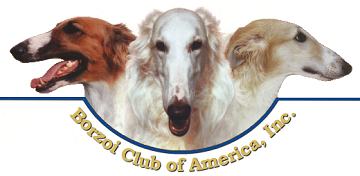
Objectives
of the Borzoi Club of America:
-
To
encourage and promote the preservation and welfare of the pure bred
Borzoi and to do all possible to bring the Breed's natural qualities
to perfection.
-
To
urge members, breeders and judges to accept the Standard
of the Breed, as approved by the American Kennel Club, as the
only Standard of excellence by which the Borzoi shall be bred and
judged.
-
To
urge members and breeders to abide by the Code of Ethics and the Guidelines
for Breeders of the Borzoi Club of America, Inc.
-
To
do all in its power to protect and advance the interest of the Breed
by encouraging sportsmanlike competition at dogs shows and Borzoi
affairs.
-
To
conduct licensed and sanctioned specialty shows under the rules of
the American Kennel Club and to perform required duties as Parent
Club of the Breed.
-
To
encourage the organization of independent local Borzoi specialty
clubs in those localities where there are sufficient fanciers of the
Breed to meet the requirements of the American Kennel Club.
BORZOI
BOOKS
All About Borzoi - The Borzoi Club of Northern California, Inc. -
1968.
Borzoi - Winifred Chadwick, Kingsprint Limited - 1971 and 1977.
How To Raise and Train A Borzoi - Gail Roberts, TFH Publishing -
1964.
Hutchinson On Sighthounds - Walter Hutchinson, Hoflin - 1976 -
reprint.
Life With Borzoi - Phydelma Gillette, Hoflin - 1977.
Observations on Borzoi - Joseph B. Thomas, Hoflin - 1976 -
Reprint.
Riders of the Wind - Mary Tavener, Reprinted by Riders of the
Wind.
The Complete Borzoi - Lorraine Groshans, Howell Book House -
1981.
The Borzoi - The Borzoi Club of America, Inc - 1973.
The Borzoi - John Gordon, ARCO - 1974.
The Borzoi - Stedman Chumway Hanks, Hoflin, 1977 - Reprint.
The Borzoi As I Know It - Arthur Craven, Hoflin - 1977 - Reprint.
The Life and Legends of the Borzoi - Eileen Worthing, Hoflin -
1977.
The Russian Wolfhound - Nellie L. Martn, Hoflin - 1977 - Reprint.
Your Borzoi - Alfred W. Edlin, M.D., Denlinger - 1976.
Unfortunately, many of these books are out of print and you many have
difficulty locating them. Those noted as reprints many possibly still be
available. For additional information, write to: Hoflin Publishers, LTD,
4401 Zephyr Street, Wheat Ridge Colorado 80033-3299. Check pet wholesale
catalogs as many of them carry books. Used bookstores are a source for
some for the out of print books as well as copies of some of the newer
books.
BORZOI
LINKS :
Find
the Perfect Dog
Breed Selector Quiz
| Breeds
Alphabetical
| Pets
Search
Categories
| Care
& More |
Suggested Books
|
Photo Extravaganza
| Popular
Mixed Breeds
Find
a Breeder |
Cat Breeders
|
Puppies For Sale
|
Classified Ads
|
Custom
Mouse Pads |
Spike The Bulldog
FAQ
| Survey
| Link
to Dog Breed Info®
| In
Loving Memory
| Doggie
Books
Dog
Products |
Doggie
Classics |
Rescue
|
Updates
|
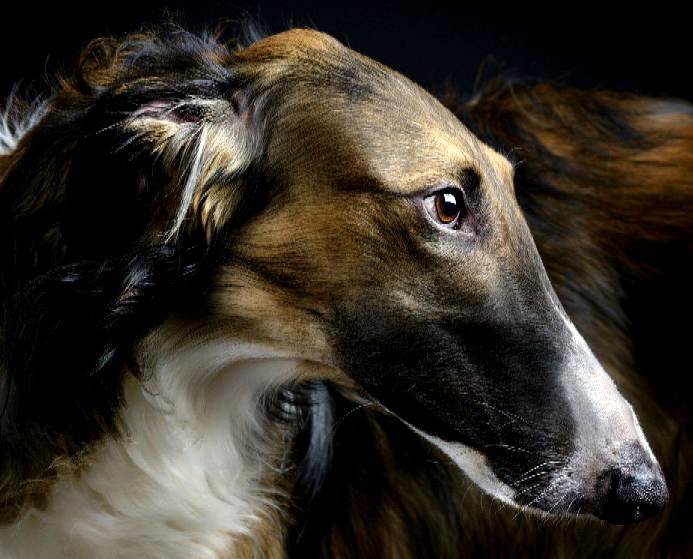
|
See
the Car development build stages of the Borzoi prototype car using the
links below:-
|

|
Borzoi
Chassis | Borzoi
Bodywork | Borzoi
Joystick | Borzoi
Styling | Borzoi
Engine
CHASSIS |
LOADING-SERVO |
CARTRIDGE | MOTORS |
INSTRUMENTS |
WIND-TUNNEL

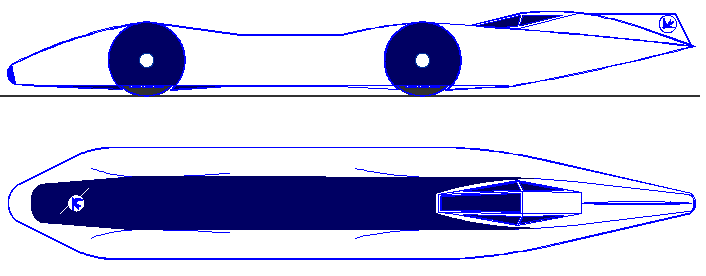
|
If
your land speed record car cannot refuel itself like this, you are
at a huge disadvantage. Blueplanet is around 66% the weight of a
car that does not have cartridge exchange refueling for the same
performance.
 Blueplanet
has inbuilt battery loaders. It does not need a
Blueplanet
has inbuilt battery loaders. It does not need a 
complicated
service station to refuel itself in under 2 minutes. |
|
 BORZOI RUSSIAN WOLFHOUND
BORZOI RUSSIAN WOLFHOUND







